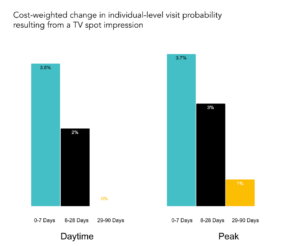
After more than 40 years of operation, DTVE is closing its doors and our website will no longer be updated daily. Thank you for all of your support.
ITV and ViewersLogic report reveals Peak TV ad spots deliver long-term uplift

Source: ITV
ITV in collaboration with ViewersLogic has built a cross market study that connects individual level advertising exposures to web visits and measures the effectiveness of ads over a longer 90-day window.
According to its findings, ITV’s new research The Hidden Value of Peak, produced using ViewersLogic’s single-source data, revealed peak TV spots deliver direct responses in the short term, but also generates responses long after other TV spot advertising has finished working.
The broadcaster harnessed ViewersLogic usingle-source data derived from its 1:1 matched panel, which measures the media consumption, online and offline purchases, and location data over time for the same individual following TV and online advertising exposure.
ITV’s Measurement Innovation Team measured the impact of TV exposures in different dayparts across 3 time windows (0–7 days, 8–28 days and 29–90 days) using logistic regressions, analysing the web traffic uplifts from each. A set of 150 models was created, each one measuring the effectiveness of TV spot advertising for a single brand in one time window, from 7 days to 3 months all including control variables.
The study foundthe short term (0–7 days after broadcast), peaktime ads deliver a 3.7% cost weighted uplift in visit probability among people who see them, delivering additional web visits at similar cost per response to daytime. In the medium term (8–28 days after broadcast), uplifts from all types of TV spots naturally fall away, and in this window peak time spots create a 3% cost weighted uplift in visit probability, but effectiveness drops even faster for daytime spots. In the longer term (29–90 days after broadcast), peaktime ads keep going and going, delivering a 1% cost weighted uplift in visit probability long after other placements have stopped creating measurable uplifts. An advertiser that measures the effectiveness of their TV spots using a response window of 7 days or less, may be underestimating the benefits of peak time spots by 1.4x
The companies noted focusing on the short term (5–10 minutes) inevitably leads to underestimating the cumulative response to advertising and this is true of daytime spots as well as peak.
Ronny Golan, CEO and co-founder of ViewersLogic, said, “Relying on short-term measurement of TV advertising only captures a narrow window of responses, but seeing the full story of campaign performance has not been possible — until now. Single-source data enables, for the first time, response windows to be confidently measured over whatever time scale the advertiser desires, deep into the long-term. Unshackled from arbitrary time limitations, brands can suddenly see the hidden value of peak slots, strengthening the data needed for strategic campaign planning and maximisation of TV budgets.”
Kate Waters, Director of Client Strategy and Planning at ITV, added, “The Hidden Value of Peak study sends a clear message. In the longer term, peak placements are more cost effective. Advertisers who focus on first-week ROI and ignore peak are shutting down the most efficient and long-lasting motor for customer response. Peak placement is like the Duracell bunny — its benefits go on and on…”


